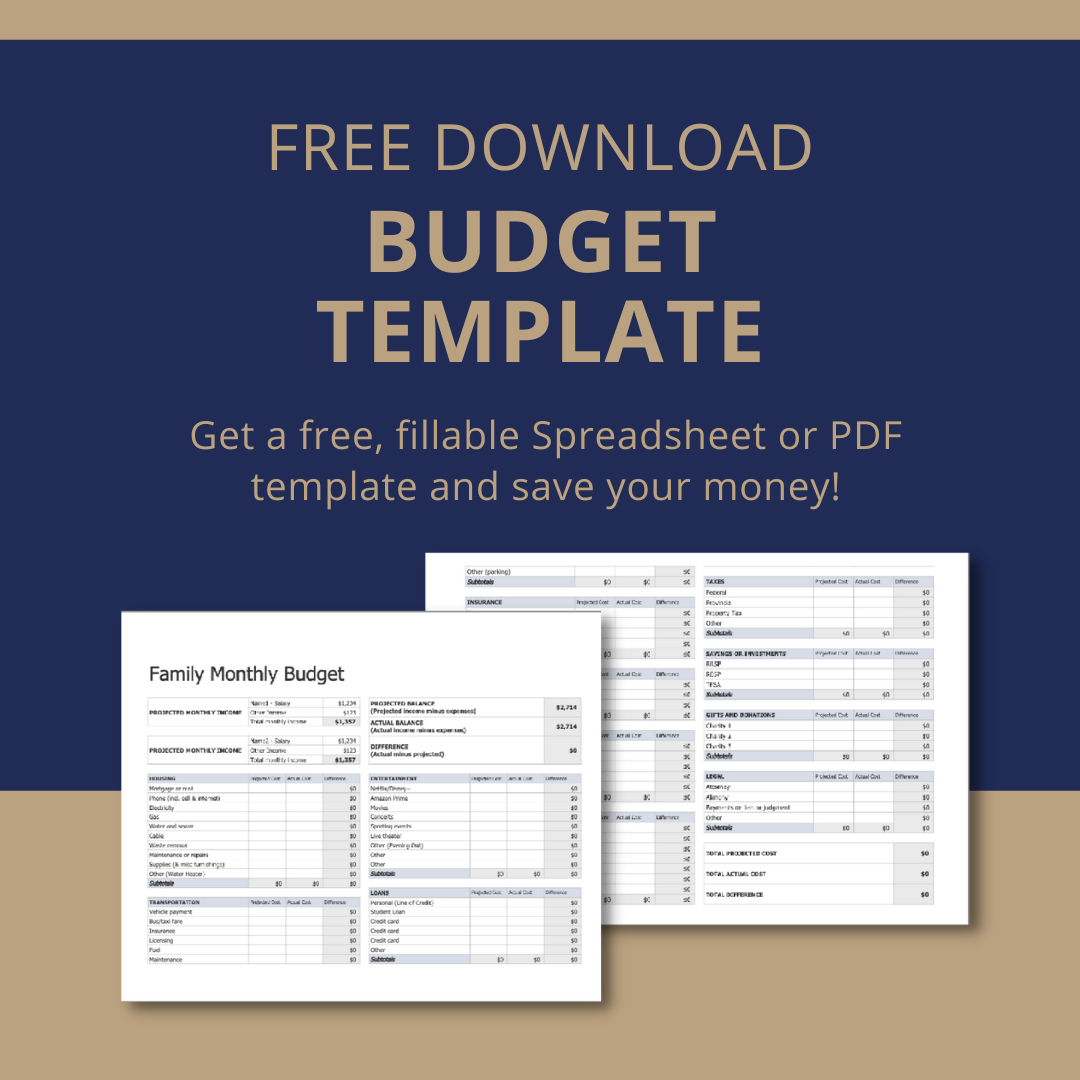How to Make a Budget
(Five-minute read time)
Getting your finances in order can seem daunting, but it doesn’t have to be. By simply creating and adhering to a clear budget, you can gain control over your spending and begin moving toward your financial goals.
A common misconception about budgeting is that it requires tons of work. That’s not true! In this article, we’ll guide you through the steps necessary to create a solid and realistic budget that will help you in your financial journey.
Get a Free Budget Template
Stay on Track with Your Financial Plans
Manage Your Spending
The first step to strong budgeting is understanding the basics. And when you break it down, saving money really isn’t complicated: spend less than you make. That’s it.
Of course, it’s often easier said than done. Understanding and remembering the basis of what you’re trying to achieve through your budgeting process is essential to your success. So, with that in mind, let’s dive into how you can go about creating a budget that will help you to spend less than you make.
Track Your Spending
Before you go about building a realistic budget for your lifestyle, you should do a little bit of research into your current spending habits to use as a base. Track all of your spending over the span of a month and separate your expenditures into general categories. We’ve created a Free Budget Template that you can use to track your expenses and use as a base as you create your own personalized solution!
Once you’ve tracked your spending for at least a month, you can use that as a baseline as you create your own personal budget. You can also track all your income streams to clearly understand your money in vs. money out. Make a note of areas with excessive spending and keep those categories in mind as areas to cut back when you build your budget.
Consider Regular Expenses
There are various tiers to a strong budget. First are the regular, often non-negotiable expenses. This includes things like rent or mortgage payments, utility payments, transportation costs, grocery bills, and recurring subscriptions.
These are the expenses that, for the most part, are unavoidable. While you may be able to cut down your monthly grocery bill a bit or forgo your gym membership to instead work out at home, things like housing costs and transportation are regular expenses that you can expect and plan for.
Account for Spontaneous Spending
Outside of these regular expenses are areas of spontaneous spending. This might include things like:
Entertainment (movies, concerts, shows)
Social events (restaurants, alcohol, weddings)
Shopping (clothes, cosmetics, home décor, gifts)
These expenses, although not required, are still an important part of leading a healthy and balanced life. They should be relative to your financial situation (remember, spend less than you earn). The trick is by intentionally building these costs into your budget, you can help you get your finances under control without completely cutting out the things you enjoy.
Expect Unexpected Costs
Life can be unpredictable, and with that comes the inevitable unexpected costs. Things like sudden car repairs, healthcare emergencies, and vet bills are all costs that show up without notice, but they’re also things we can plan ahead for.
Keep in mind that that single month of tracked spending works wonderfully for giving you a general idea of your spending habits, but it doesn’t show the whole picture. These unexpected costs are also a part of your overall expenses and should be considered when creating a solid budget plan.
An emergency fund can greatly help in these times of stress – we'll discuss that more below.
Plan Ahead for Larger Purchases
Next come the expected but less common expenditures. Larger purchases like a new laptop, a vacation, a new vehicle, or even holiday season gift-giving are all larger expenses that you can plan for in advance.
Consider establishing a sinking fund in advance that you can use to slowly save up for those larger purchases. You can create a separate account dedicated to your sinking fund, or simply keep an amount of money in your standard account allotted to the sinking fund.
You can create a sinking fund for anything under the sun. You can contribute as much or as little to it as you’d like to keep yourself financially sound. Take Christmas, for example. Rather than spending $1000 in December for all of your Christmas gifts, you could instead choose to create a holiday sinking fund at the start of the year and contribute monthly. $85/month is a lot more manageable than $1000 all at once!
Use sinking funds for those expected purchases and work them into your budget without unnecessary financial strain.
Remember Your Goals
These cover the main considerations in a strong budget – regular expenses, spontaneous expenses, unexpected costs, and large purchases. Once you’ve accounted for these areas, you’re well on your way to creating a comprehensive and realistic budget to suit your lifestyle.
Don’t forget to keep your goals in mind when you go about this process. It can be frustrating to adhere to a budget, especially if you’re not used to paying close attention to your spending habits. But you’ve set out to create a budget for a reason, and keeping those goals in mind is the most effective motivation for sticking to your budget until it’s second nature.
Set a Plan for Any Excess
Now that you’ve accounted for all main areas of spending, you hopefully have some funds left over. After all, to save is to spend less than you make. The question is, what do you do with that excess?
You have options. Firstly, you should try to establish an emergency fund. An emergency fund is an account with a chunk of money that you can use if you encounter some sort of an emergency – a job loss, a health scare, or a home disaster, for instance. This safety net can help to keep you afloat and avoid having to take out a loan to cover costs while you recover.
The general rule of thumb is to keep 3-6 months of expenses in your emergency fund, though you can start smaller and build up. An emergency fund is also typically smaller for individuals compared to people with families to support.
Past that, you can funnel your extra funds into a high-interest savings account, or you can consider investing. If investing interests you, feel free to consult with a financial advisor to discuss your options.
Continually Review Your Budget
That’s it. You’ve created a comprehensive budget that will help you to reach your financial goals! The hard part is over, and now it all comes down to consistency and commitment. As you go through life using your newfound budget tool, be sure to continually review your budget and make sure that it still suits your lifestyle and your needs.
As your income and your life situation change, your goals will also change. Regularly review and tweak your budget to ensure it's still helping you reach those goals.
Budgeting can be a simple process. Make use of our Free Budget Template to get yourself started, and you’ll be well on the way to financial freedom!
Get a Free Budget Template
FAQ about Budgeting in Ontario
-
Budgeting is crucial because it helps you manage your money, track your spending, and plan for future financial goals. By creating and adhering to a budget, you can avoid debt, save for emergencies, and achieve financial stability.
-
To start creating a budget, track your spending for a month to understand where your money goes. Separate your expenses into categories, such as regular expenses, spontaneous spending, and unexpected costs. Use this information to create a realistic budget based on your income and spending habits.
-
Your budget should include regular expenses (rent/mortgage, utilities, groceries), spontaneous spending (entertainment, dining out), unexpected costs (car repairs, medical bills), and larger purchases (vacations, gifts). Additionally, plan for savings and emergency funds.
-
Use tools like budget templates, or spreadsheets to track your spending. Record every expense, categorize it, and review your spending habits regularly. This will help you identify areas where you can cut back and save money.
Download our free budget template to get started.
-
A sinking fund is a savings strategy where you set aside money regularly for expected, larger expenses. For example, if you plan to spend $1000 on Christmas gifts, you can save $85 per month throughout the year. This helps you manage large expenses without financial strain.
-
Aim to save 3-6 months' worth of living expenses in an emergency fund. This fund acts as a safety net for unexpected events like job loss or medical emergencies. Start with a smaller goal and gradually build it up over time.
-
To reduce regular expenses, consider cost-saving measures like meal planning to lower grocery bills, or renegotiating service contracts (e.g., internet, phone). Small changes can add up to significant savings.
-
Inflation can significantly impact your budget by increasing the cost of goods and services. To manage this, regularly review and adjust your budget to reflect rising prices. Look for ways to cut back on discretionary spending and prioritize essential expenses. For more detailed strategies on managing your finances during inflation, check out our comprehensive guide:
-
After covering all your expenses, allocate leftover money to savings, investments, or paying off debt. Establishing an emergency fund should be a priority, followed by contributions to a high-interest savings account or investment options. Consulting a financial advisor can help you make informed decisions.
To learn more, read our article: What Should I Do with My Tax Refund?
-
Regularly review your budget, ideally monthly, to ensure it still aligns with your financial goals and lifestyle changes. Adjust your budget as needed to accommodate changes in income, expenses, or financial priorities.
Recognized By
Interested in Learning More About Investing?
Check out our additional resources:










